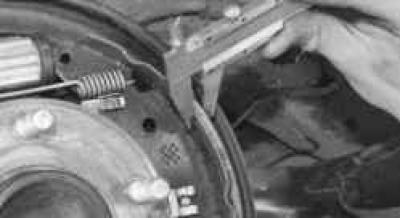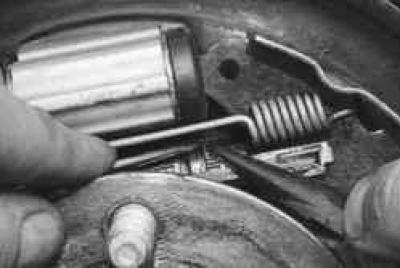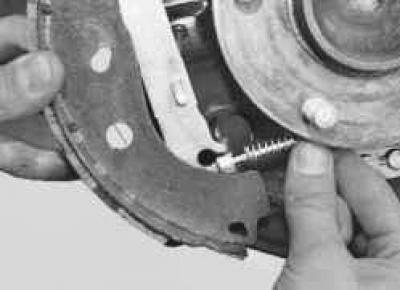
NOTE: It is difficult to measure the thickness of a completely worn brake pad with sufficient accuracy. Therefore, measure the total thickness of the pad and subtract the thickness of the base of the pad from the resulting value (2.0mm).
Replace pads in the following cases:
- the thickness of the friction linings is less than the allowable value;
- the surface of the pads is oiled;
- the friction lining is loosely connected to the base;
- linings have deep grooves and chips.
WARNING: Do not use gasoline, diesel fuel or any other mineral solvents to clean brakes.
WARNING: Change pads at the same time in the brake mechanisms of both rear wheels.
You will need: a wheel nut wrench, thin-jawed pliers, a flat-blade screwdriver, sliding pliers with locking.
1. Engage first gear and chock the front wheels.
2. Check that the parking brake lever is pushed all the way down (the car is disinhibited).
3. Remove the wheel (cm. «Wheel replacement») and put the car on a stand.
4. If the brake fluid level in the master cylinder reservoir is at the mark «MAX» or approaches it, pump some of the fluid out of the tank. Otherwise, when replacing the pads, it may splash out.
5. Remove the brake drum (cm. «Removal and installation of a brake drum»).

6. Turn up..

7.... and remove the clamping brackets of both brake pads by pulling them towards you.

WARNING: It is difficult to access the clevis posts from the back of the brake shield. Therefore, make sure that the posts do not move deep into the holes in the shield, and do not remove the posts unless absolutely necessary.

8. If you remove worn brake pads to replace them with new ones, first set the gap adjuster to its original position, for which press the spring stop of the adjuster ratchet mechanism up with a screwdriver..

9.... and, holding the stop, tighten the gear nut of the regulator with pliers until it stops, turning it clockwise.

10. Using a screwdriver, unhook the bent end of the upper coupling spring from the rear shoe with pliers, unhook its other end from the front shoe and remove the spring.
WARNING: Be careful when working with pliers and a screwdriver. We recommend using special pliers to remove the coupling springs.

11. Slightly pull back the rear shoe and remove the spacer bar assembly with the clearance adjuster.

12. Move the brake shoes down, removing them from the bottom stop on the brake shield to loosen the tension of the lower return spring, remove the spring and the front shoe.

13. Move back the end of the rear cable extension in the groove of the expansion lever so that it matches the slot in the lever..

14.... disconnect the tip of the cable from the expansion lever and remove the rear brake shoe.
WARNING: Immediately after removing the pads, secure the pistons of the working cylinder in any way possible (for example, tie with a rubber band or tie with wire), Otherwise, the pistons may be pushed out of the cylinder by the spacer spring and brake fluid will leak out of the hydraulic system.
WARNING: With the pads removed, do not press the brake pedal, as pistons will be pushed out of the working cylinder and brake fluid will flow out of the hydraulic system.

Pic. 9.5. Rear wheel brake parts (shows details of the brake mechanism on the right side): 1 - rear brake shoe of the rear wheel; 2 - clamping bracket; 3 – expanding lever of the parking brake; 4 - spacer bar with clearance adjuster; 5 - upper coupling spring; 6 - working cylinder; 7 - extension of the rear cable of the parking brake; 8 – a forward block of the brake mechanism of a back wheel; 9 - lower coupling spring
15. Clean and inspect brake parts (pic. 9.5). Replace deformed or heavily corroded parts. Strongly stretched, lost elasticity and bent springs replace.
GOOD ADVICE: Whenever disassembling the brake mechanism, replace the clamping brackets with new ones.
USEFUL ADVICE: When replacing brake pads, we recommend replacing the spacer bars assembled with clearance adjusters if they have begun to corrode, since during further operation corrosion can cause clearance adjuster failure.
NOTE: The left brake adjuster parts are not interchangeable with the corresponding right brake parts - do not mix them up!
NOTE: Front 8 (see fig. 9.5) and rear 1 rear brake pads are different in design (the parking brake release lever is attached to the rear shoe with the help of a riveted axle, and the friction lining of the front shoe is shorter but thicker than that of the rear shoe). In addition, the rear brake pads are different as left and right.

16. Apply refractory brake grease to the friction points of the front and rear brake pads on the brake shield.
17. Release the pistons of the working cylinder from the fixing device, squeeze the pistons of the working cylinder with sliding pliers and install the brake shoes in the reverse order of removal.
WARNING: Keep in mind that when the pistons are sunk into the cylinder, the level of brake fluid in the reservoir of the master brake cylinder rises. Pump out the fluid if necessary.
18. Install the brake drum (cm. «Removal and installation of a brake drum»).
19. Adjust the clearance between the brake shoes and the drum by pressing the brake pedal 10-15 times. Each time you press it, you should hear the knob click. If the clicks stop, the clearance is set.
20. Reinstall the wheel. Check for ease of rotation.
21. Similarly replace the brake pads of the brake mechanism of the other wheel.
22. After installing the brake pads, adjust the parking brake system (cm. «Parking brake actuator adjustment»).
Visitor comments